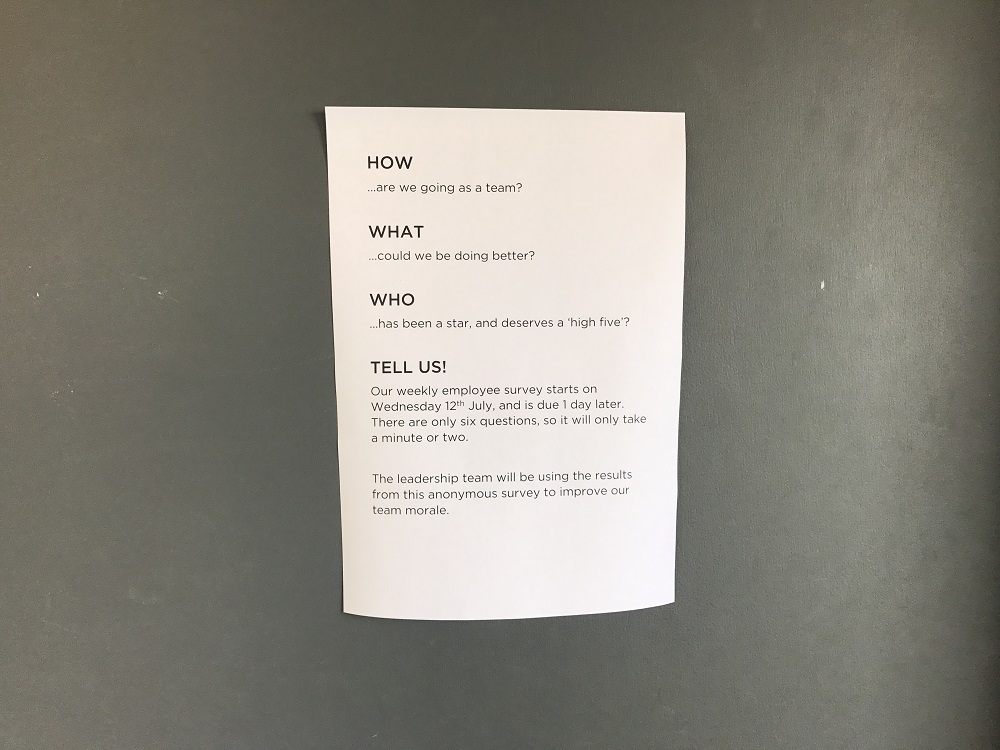You’ve made the decision to start using pulse survey software to collect team feedback – congratulations! Before you do, you need to plan to get the most from your new initiative. This article explains the proven methods to achieve best results.
Smart leaders know that gathering employee feedback is vitally important for all businesses – they are, as we say, the lifeblood of any organisation. Employees feel more engaged, better able to contribute and most importantly, valued, when they have an outlet for opinions, such as using pulse survey software to regularly give their thoughts.
We have seen some great and not so great examples of organisations using pulse survey software with their teams. With these lessons in mind, I wanted to write a comprehensive guide to the main five steps to success you should consider.
Five steps to success
Basically, we can break this all down to five key steps to get the most out of your surveys. These are;
- Get leadership buy in
- Have a communications plan
- Follow up
- Take action
- Rinse and repeat
Let’s go through each of these steps, so we all understand the best methods when using pulse survey software.
Related article: Everything You Need to Know About Employee Pulse Surveys
Get leadership buy in
The top leader and HR (and/or consultant) should meet with the senior team to discuss commitment to using pulse survey software. That is, the overall plan for the coming months, and the expected benefits to each senior leader. The goal is to gain buy-in and set realistic expectations for time commitment.
If you have trouble getting buy in from senior leadership, the pulse survey is going to fail.

You should start by explaining the purpose of using pulse survey software and other tools to collect feedback and increase employee engagement. You may need to explain what employee engagement is, why it matters, and how it will benefit the organisation and all stakeholders.
A good way to do this, is to highlight the benefits of employee engagement; increased morale and performance, reduced staff turnover, and the resulting enhanced leadership impact.
Get into detail as much as you can. That is, outline the survey proposed dates and logistics, making sure you cover expectations for each of your senior leaders and explain what support will be provided to each leader and possibly team managers.

Corporate woman and building. Credit: Stock Snap.
Communicate to the team
Once you have made a commitment to using pulse survey software, you need to implement an internal communication plan. This is absolutely critical to getting active participation from everyone in your survey.
Team members need to know the four W’s, that is;
- Why a pulse survey is taking place?
- When will it roll out and any deadlines?
- Where they should expect to receive it (email, SMS, Slack, etc)?
- What will the results be used for?
You should state that all responses will be anonymous (that is, if they actually are) and that any data being collected is being collected by a reputable third party (Employees are known to not trust internally administered surveys). Encourage employees to respond candidly and get in front of any potential trust issues that might exist.
If you highlight the benefits to each employee, and explain to them what they can expect to gain from this survey, you will be framing the purpose in the right way – explain how you’ll use the feedback to provide a better environment or whatever your objectives are.
Providing all this detail ensures employees understand the purpose of using pulse survey software to collect their feedback, and will ensure they are more inclined to provide honest feedback.
Ideally, this should all be sent out around one week prior to the survey starting, to ensure ample time to answer any feedback or concerns. Any earlier, and it may be that some people will forget entirely.
Related article: How Employee Pulse Surveys Can Benefit HR Managers
Example noticeboard message
If your team are all in the one office, it may be prudent to post a message on the team noticeboard or a high traffic wall. Here’s an example from one of our customers.

Example of communicating you are using pulse survey software
Example email announcement
If you have a company wide email list, you may ask one of the senior leadership to send an email to everyone.
Hello Sarah,
During next week, we will be conducting a company-wide employee survey. We are conducting this survey in order to get a better understanding of employee morale, satisfaction, and engagement at Example Inc. Your opinions are important to us, and this survey is your chance to express those opinions.
We will use the survey results for three purposes:
- to recognise where we need to improve as a company;
- to look for areas we excel at, so we can see what we are doing well, and;
- to fix problems that are affecting you.
This pulse survey is being managed by an independent third party. They will send all invitations and reminders and collect all the data. Your response will remain strictly anonymous. Please be thoughtful, honest, and candid when you give feedback.
Once we have all the responses collected, the management team and HR leader will review the overall trends and may meet with some teams to discuss how we can improve our culture and performance.
The results of this will mean that Example Inc will become a better place to work.
We hope to get a high participation rate, to ensure that every employee’s voice is heard. Please take part next week.
Regards
Mrs Leader
Example Slack announcement
If you use an internal chat tool, such as Slack, you may find it better to use this to announce. Note, however, that some team members may not check this as frequently as you would like.

Announcing employee survey by Slack
Follow up
This is an absolutely critical part of the process – the post survey follow up.
The first step should be to thank everyone for taking part in the pulse survey, by providing their candid feedback. This could be done either in a team stand up, via usual messaging channels or a company-wide email.
If you received a high response rate (most pulse survey software can show this), you should announce this too, when praising your team.
This next step can be uncomfortable at times, however I believe you should share the results of your surveys with the entire team.
Some organisations share the reports only with direct managers or the leadership team, however I feel that whilst this is important, the entire organisation needs to hear at least something.
Not sharing at least some high-level results reinforces many of the things that have a negative impact on employee engagement and satisfaction. Sharing at least some of the overall results with your team signals trust, openness, and most importantly, respect.
It’s also important to share both ‘good’ and ‘bad’ responses, although we see all feedback as positive in it intent.
Face it, it’s more than likely your employees already know what the problems are. Acknowledging these problems openly will help you gain credibility and respect.
Take action!
This is the most important step. If you are using pulse survey software to collect employee feedback and then doing nothing with it, this can be worse than not asking at all.
Put yourself in your teams shoes; it can be very disenfranchising for employees to spend their time and effort in responding to your survey, to then find that nothing happens as a result; this will often make your people feel ignored and not valued.

Reviewing employee pulse survey results
Rinse and repeat
One of the most important steps when using pulse survey software is that you continue to use these pulse surveys. Before even completing the current one, you should already know when you will send the survey again.
Comparing the results across a number of surveys will allow you to see what effect any actions you’ve done in the step before have made to your team.
The most popular method to actively manage company culture and drive employee engagement is using employee engagement surveys.
Source: CultureIQ
The point of doing this regularly is about building a habit of communication. The more open your employees can communicate to leadership, the stronger the team dynamic. If you use the High Fives feature in 6Q, it’s also about creating an environment of regular gratitude.
In Summary
Now we’ve seen the best methods when using pulse survey software. The main five points again, are;
- Get leadership buy in
- Have a communications plan
- Follow up
- Take action
- Rinse and repeat
We wish you all the best with implementing and running your pulse surveys!



